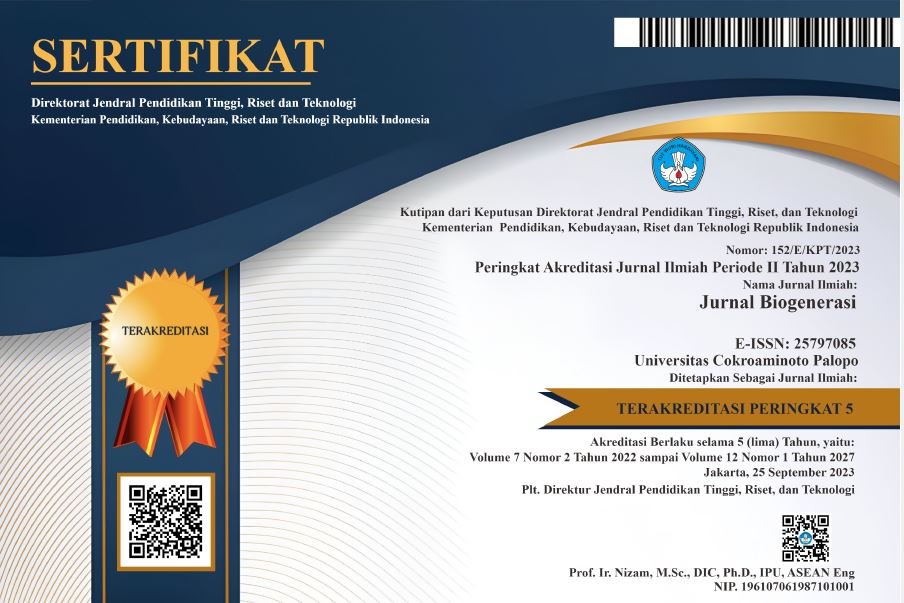EKSPLORASI NILAI-NILAI KARAKTER DAN ASPEK PEMBELAJARAN IPA DALAM GERAKAN TARI TRADISIONAL TOGO POU SUKU PALUE
DOI:
https://doi.org/10.30605/biogenerasi.v10i2.5434Keywords:
Traditional Togo Pou Dance, Character Values, Science Education, Palue Ethnic GroupAbstract
This study aims to explore the character values contained in the traditional Togo Pou dance of the Palue ethnic group and to examine the potential aspects of Science Education (IPA) that can be derived from the movements of the dance. Togo Pou is a traditional dance from the Palue ethnic group in Sikka Regency, East Nusa Tenggara, which reflects the behavior patterns of the community through dance movements accompanied by gong and drum music. Each dance movement mirrors the meaning contained in the lyrics of the song, which invites the community to work together on tasks that cannot be done alone, such as building a boat. This research uses a qualitative approach with data collection techniques through interviews and documentation. The collected data is analyzed using the Miles and Huberman analysis model, which includes data collection, data reduction, data presentation, and drawing conclusions. The subjects of this research are the people of Dusun Lomite Bhako and traditional leaders who have a deep understanding of the meaning of the dance. The findings show that the Togo Pou dance contains character values such as religiosity, love for peace, social care, and friendliness and communication. The conclusion of this study is that this dance is not only a cultural heritage but also serves as a means to teach character values and Science Education, such as balance and coordination, which are beneficial in elementary school education.
Downloads
References
Abdullah, F. (2020). Wacana Tuna-Budaya dan Tuna-Sejarah pada Generasi Masa Kini. Puitika, 15(2), 98–107.
Anggraini, D., & Hasnawati, H. (2016). Perkembangan Seni Tari: Pendidikan dan Masyarakat. Jurnal PGSD: Jurnal Ilmiah Pendidikan Guru Sekolah Dasar, 9(3), 287–293.
Boangmanalu, M. P., & Pasaribu, P. (2024). Makna Tradisi Tangis Sijahe Dalam Perkawinan Adat Pakpak di Desa Boangmanalu Kecamatan Salak. Journal of Management Education Social Sciences Information and Religion, 1(2), 576–583.
Ghozali, M. A. (2015). TA: Penciptaan Buku Ilustrasi Tari Topeng Panji Malangan untuk Mempopulerkan Budaya Tradisional Kota Malang Kepada Remaja. Institut Bisnis dan Informatika Stikom Surabaya.
Mustari, M., & Rahman, M. T. (2011). Nilai karakter: Refleksi untuk pendidikan karakter. Laksbang Pressindo.
Simamora, Y. A., & Sibarani, R. (2022). Tradisi Permainan Rakyat pada Etnik Batak Toba: Kajian Kearifan Lokal. Journal of Language Development and Linguistics, 1(2), 71–86.
Wulan Suci, D. (2019). Manfaat Seni Musik Dalam Perkembangan Belajar Siswa Sekolah Dasar. Edukatif: Jurnal Ilmu Pendidikan, 1(3), 177–184.
Putra, S. H. J. (2021a). Effect of Science, Environment, Technology, and Society (SETS) Learning Model on Students’ Motivation and Learning Outcomes in Biology. Tarbawi : Jurnal Ilmu Pendidikan, 17(2), 145–153. https://doi.org/10.32939/tarbawi.v17i2.1063
Putra, S. H. J. (2021b). Pendekatan Jelajah Alam Sekitar (JAS): Dampaknya terhadap Aktivitas dan Hasil Belajar Kognitif Siswa SMP. Journal of Natural Science and Integration, 4(2), 204. https://doi.org/10.24014/jnsi.v4i2.10030
Yangsen, B. R. (2023). Eksplorasi Nilai-Nilai Multikultural dalam Sastra Anak Sumbawa sebagai Revitalisasi Pendidikan Nilai dan Karakter. Jurnal Onoma: Pendidikan, Bahasa, Dan Sastra, 9(2), 871–880
Downloads
Published
How to Cite
Issue
Section
License
In submitting the manuscript to the journal, the authors certify that:
- They are authorized by their co-authors to enter into these arrangements.
- The work described has not been formally published before, except in the form of an abstract or as part of a published lecture, review, thesis, or overlay journal.
- That it is not under consideration for publication elsewhere,
- That its publication has been approved by all the author(s) and by the responsible authorities – tacitly or explicitly – of the institutes where the work has been carried out.
- They secure the right to reproduce any material that has already been published or copyrighted elsewhere.
- They agree to the following license and copyright agreement.
License and Copyright Agreement
Authors who publish with this journal agree to the following terms:
- Authors retain copyright and grant the journal right of first publication with the work simultaneously licensed under Creative Commons Attribution License (CC BY 4.0) that allows others to share the work with an acknowledgment of the work's authorship and initial publication in this journal.
- Authors are able to enter into separate, additional contractual arrangements for the non-exclusive distribution of the journal's published version of the work (e.g., post it to an institutional repository or publish it in a book), with an acknowledgment of its initial publication in this journal.
- Authors are permitted and encouraged to post their work online (e.g., in institutional repositories or on their website) prior to and during the submission process, as it can lead to productive exchanges, as well as earlier and greater citation of published work.


.png)

